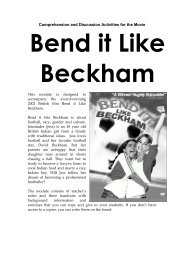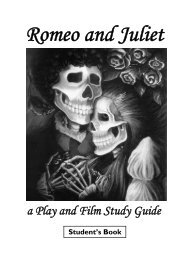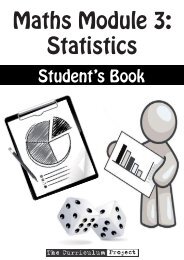Download - The Curriculum Project
Download - The Curriculum Project
Download - The Curriculum Project
You also want an ePaper? Increase the reach of your titles
YUMPU automatically turns print PDFs into web optimized ePapers that Google loves.
5.3 What does nationality mean?A. Read the information about nationality. Clarify anything the students don’t understand. In groups,students answer the questions from the point of view of the people in the example.Answers:1. Pa-O woman – ‘I’m Burmese’ Zulu man – ‘I’m South African’Vietnamese family – ‘We’re Australian’2. Pa-O woman – ‘I’m Pa-O’ Zulu man – ‘I’m Zulu’Vietnamese family – ‘We’re Vietnamese’3. Pa-O woman – ‘I’m Pa-O, from Burma’ Zulu man – ‘I’m Zulu, from South Africa’Vietnamese family – ‘We’re Vietnamese, but we live in Australia now’B. Discuss this situation in groups.Possible answers:1. ‘I’m Mon’ – to other Mon people, to people fromThailand or Burma, to friendly people who areinterested in his nationality and want more information.2. ‘I’m Thai’ – to people who know nothing aboutMon people and he doesn’t want to spend a longtime explaining his background.3. ‘I’m British’ – to officials.Language/Culture NotesNationality can mean being a citizen of acountry, or a member of an ethnic group.Ethnicity only refers to membership of anethnic group.Race usually only refers to commonphysical characteristics of a group ofpeople, such as skin colour, hair type, andnose shape.5.4 InterrogationA. Pre-teach interrogation, fake. Copy and cut out the fake IDcards on page 109 of the Teacher’s Book. Give one to each student. If you can’t copy the page, tell studentsto make up the following false information about themselves and write it down: name, date of birth, place ofbirth (city and country), nationality, place their visa was issued, and date of entry into the country.Give students one or two minutes to memorise their new identities.B. Play audio 10.7. Students answer the questions according to their new information. Not all the informationthey need is on the ID card, so they will have to think quickly, and make up answers to some questions.Repeat this activity two or three times. <strong>The</strong>y should count how many times they make a mistake!C. In pairs, students roleplay this situation. One person is interrogator (the person asking questions), trying toget the other to make a mistake. Get a few pairs to perform their interrogation to the class.6. Reading: An Indian PoetThis section provides reading comprehension and critical thinking exercises, based on the life and works ofRabindranath Tagore, India’s most famous poet.6.1 Background informationA. Brainstorm about Indian history. Write students’ ideas on the board. Point out that:<strong>The</strong> British started to colonise India in the 17th century, and controlled the whole country by1857. India gained its independence in 1947.B. Students look up the new vocabulary in their dictionaries, or elicit meanings from students and writethem on the board. Some of the vocabulary items can have more than one meaning.NOTE: Men and women can be knighted by the King or Queen of England for their achievements orservice. If you are are awarded a knighthood you can use the title Sir (male) or Dame (female). Fire onmeans ‘shoot at’. A gathering is a group of people together in one place.C. Discuss the phrases with the class. As a class or in groups, student think of reasons why these phrasesmight relate to Tagore and be in text. Give the example of Nobel Prize for Literature. Ask studentswhy this phrase might be in the text, and elicit or suggest that Tagore probably won this prize. Somebackground information you can explain to the students:<strong>The</strong> Nobel Prize for Literature is awarded every year to a person who has written an important book orbooks. <strong>The</strong> Amritsar Massacre in 1919 was when the British Army killed hundreds of unarmed civilians,who were protesting against British colonial rule in India. Albert Einstein was a physicist, most famous forthe theory of relativity. A country’s national anthem is its official song or piece of music.D. Students read the text. Go through their predictions in B – point out the phrases in the text and clarifyanything they don’t understand.UNIT 1033



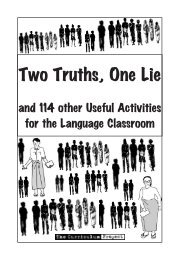
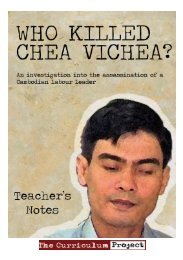

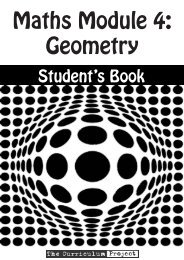

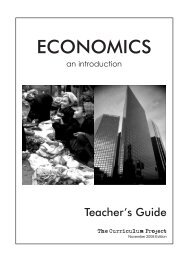
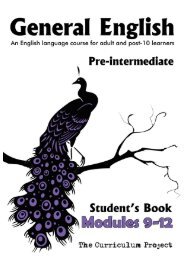

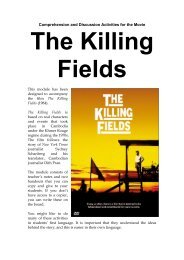
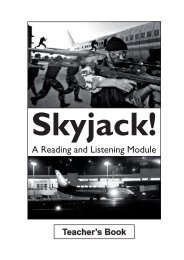
![[Eng] Nov 2012 DRAFT - The Curriculum Project](https://img.yumpu.com/45590859/1/184x260/eng-nov-2012-draft-the-curriculum-project.jpg?quality=85)
